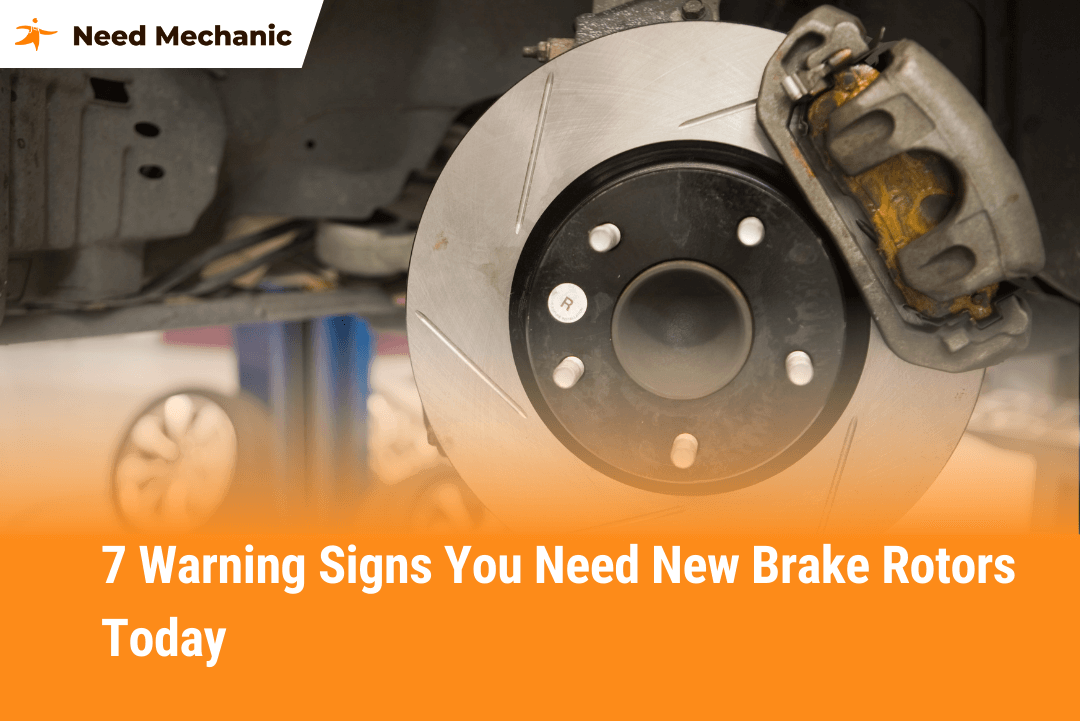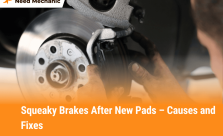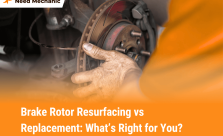The most common signs you need new brake rotors include squealing noises, vibration in the brake pedal, longer stopping distances, visible cracks or grooves, warning lights, burning smells after braking, and uneven brake pad wear. Brake rotors wear out over time, and when they do, your vehicle loses stopping power and puts you at risk on the road. Knowing these signs early can help you avoid expensive repairs and keep your car safe. In this guide, we’ll break down each of the seven warning signs in detail so you can recognize problems before they become dangerous.
Table of Contents
- 1. Squealing, Squeaking, or Grinding Noises
- 2. Vibration or Pulsating in the Brake Pedal or Steering Wheel
- 3. Longer Stopping Distances or Poor Braking Performance
- 4. Visible Damage: Grooves, Cracks, or Blue Discoloration
- 5. Brake Warning Light or ABS Alerts
- 6. Burning Smell After Braking
- 7. Uneven or Rapid Brake Pad Wear
- Why Replacing Brake Rotors Matters
- How to Extend the Life of Your Brake Rotors
- Conclusion: Stay Safe by Catching the Signs Early
- FAQs
1. Squealing, Squeaking, or Grinding Noises
One of the first and most noticeable signs of rotor trouble is unusual noises when braking.
- Squealing or squeaking usually happens when rotors become glazed, which means the surface has hardened and lost its smooth finish. This reduces stopping power and creates high-pitched sounds.
- Grinding or scraping noises often mean the rotor’s surface is heavily scored or damaged. When brake pads wear down too far, the metal backing may grind directly against the rotor, causing deep grooves.
Ignoring these sounds will only make the problem worse. Not only does it take longer to stop your car, but the damage spreads quickly to other parts of the braking system.
User benefit: Paying attention to sounds early can prevent more expensive repairs, reduce brake failure risks, and keep you safe on the road.
2. Vibration or Pulsating in the Brake Pedal or Steering Wheel
Another strong sign you may need new brake rotors is vibration when applying the brakes.
- If you feel a pulsating brake pedal, it usually means the rotors are warped. Warping happens from excessive heat, often caused by heavy braking, towing, or frequent stop-and-go traffic.
- If the steering wheel shakes when braking, this also points to uneven rotor surfaces that prevent smooth contact with the brake pads.
Even a slight vibration shouldn’t be ignored. Uneven rotors reduce stopping efficiency, and in emergency situations, even a few extra feet of braking distance can make a big difference.
User benefit: Replacing worn or warped rotors gives you smoother stops, more control, and greater confidence when driving in traffic or bad weather.
3. Longer Stopping Distances or Poor Braking Performance
Your car should stop quickly and predictably when you press the brake pedal. If you notice it takes longer than normal to stop, the rotors may be the reason.
- Worn rotors reduce the brake pad’s ability to grip properly.
- Overheated rotors lose effectiveness, a condition known as brake fade.
- Grooved rotors cause uneven contact, leading to weaker stopping power.
Drivers often confuse this symptom with worn brake pads, but in many cases, the rotors are to blame. Ignoring reduced braking performance can put you in dangerous situations, especially during sudden stops, wet roads, or when carrying heavy loads.
User benefit: Recognizing and fixing rotor issues early means shorter stopping distances, better safety for you and your passengers, and less stress in emergency braking.
4. Visible Damage: Grooves, Cracks, or Blue Discoloration
A simple way to check your rotors is by looking at them through the wheel spokes. If you see signs of damage, replacement is often necessary.
- Deep grooves or scoring: These form when worn-out pads dig into the rotor surface.
- Cracks: Heat stress can cause cracks to form, which may eventually lead to rotor failure.
- Blue or purple discoloration: Overheating leaves marks that show the rotor has been exposed to extreme heat and lost its original strength.
- Rust or pitting: Excessive rust reduces rotor effectiveness and can cause brake noise or failure.
Rotors are designed to be smooth and even. If you can see or feel irregularities, the surface has already worn down too far. While minor grooves can sometimes be resurfaced, most visible damage means replacement is the safest choice.
User benefit: By inspecting your rotors regularly, you can catch issues before they turn into full brake system failures, helping you avoid costly repairs and unsafe driving conditions.
5. Brake Warning Light or ABS Alerts
Modern vehicles are equipped with dashboard lights that warn you of brake system problems. While these lights don’t always mean rotor issues, they should never be ignored.
- The brake warning light may signal worn pads, low brake fluid, or rotor issues.
- The ABS light (anti-lock braking system) sometimes indicates sensors detecting uneven rotor rotation.
Even if the car still feels like it’s braking normally, the warning lights mean the system has detected something wrong. Waiting too long could mean the rotors, pads, or even the calipers are reaching unsafe levels of wear.
User benefit: Acting on dashboard alerts right away can prevent dangerous failures, ensure your car passes inspections, and keep your brakes working the way they’re designed.
6. Burning Smell After Braking
A sharp burning smell coming from your wheels after heavy braking is a clear red flag. This odor usually means your brakes are overheating, and overheated rotors can lose their ability to grip.
- In many cases, the smell is strongest after driving downhill or stopping suddenly at high speeds.
- If smoke accompanies the smell, it’s an emergency — the rotors and pads are overheated and at risk of complete brake fade.
User benefit: Noticing a burning smell early helps you avoid rotor warping, reduces fire risk, and ensures your braking system stays effective.
7. Uneven or Rapid Brake Pad Wear
If your brake pads seem to wear out faster than normal or wear unevenly, the rotors may be the hidden cause.
- Warped rotors create uneven contact, which grinds down pads more quickly.
- Grooved rotors damage pads by cutting into them.
- Rotor imbalance can wear one side faster than the other.
Replacing pads without fixing rotor issues is like putting new shoes on uneven ground — they’ll wear out quickly.
User benefit: By replacing rotors when they start causing uneven wear, you’ll save money on frequent pad replacements and keep your braking system balanced.
Why Replacing Brake Rotors Matters
Rotors are not just another car part — they are your last line of defense when it comes to stopping power. Driving with damaged or worn rotors increases the risk of accidents, reduces vehicle performance, and causes damage to other components like brake pads, calipers, and tires.
Replacing your rotors when needed provides several benefits:
- Better safety: Shorter, smoother, and more reliable stops.
- Lower repair costs: Prevents damage from spreading to the entire brake system.
- Peace of mind: Confidence knowing your car can stop when it matters most.
- Improved driving experience: Less vibration, noise, and stress while driving.
How to Extend the Life of Your Brake Rotors
While no rotor lasts forever, there are steps you can take to make them last longer and keep them in good condition.
- Avoid aggressive braking whenever possible. Slamming on the brakes causes unnecessary heat and stress.
- Maintain safe following distances to reduce emergency stops.
- Check brake pads regularly since worn pads damage rotors quickly.
- Avoid overloading your vehicle beyond its recommended weight, which increases rotor stress.
- Get routine brake inspections at least once a year or during tire rotations.
User benefit: By driving with care and scheduling regular maintenance, you’ll spend less money on replacements and keep your car safer for longer.
Conclusion: Stay Safe by Catching the Signs Early
Brake rotors may not be something you think about often, but they directly affect your safety every time you hit the road. From squealing noises to longer stopping distances, your car gives you clear warning signs before rotor failure becomes dangerous.
By learning to recognize these seven warning signs you need new brake rotors, you’ll protect yourself, your passengers, and everyone else on the road. More importantly, you’ll avoid costly repairs and enjoy smoother, safer driving.
When it comes to brakes, don’t wait until it’s too late. If you notice any of the signs listed above, schedule an inspection as soon as possible. Staying proactive about brake maintenance ensures peace of mind every time you drive.
FAQs
How long do brake rotors usually last?
Most rotors last between 30,000 and 70,000 miles, depending on your driving habits, vehicle type, and maintenance. Heavy stop-and-go driving wears them out faster.
Can I drive with bad brake rotors?
Not recommended. Driving with worn rotors reduces braking efficiency, increases stopping distance, and may cause complete brake failure.
Do I need to replace rotors and pads at the same time?
In most cases, yes. New pads on damaged rotors won’t perform well, and new rotors with old pads may wear unevenly. Replacing both ensures proper performance.
What’s the difference between resurfacing and replacing rotors?
Resurfacing smooths out minor grooves but reduces rotor thickness. If rotors are below the safe thickness or have cracks, replacement is the only safe option.
How much does it cost to replace brake rotors?
Costs vary by vehicle, but typically range from $150 to $400 per axle, including both parts and labor.






Leave a Reply